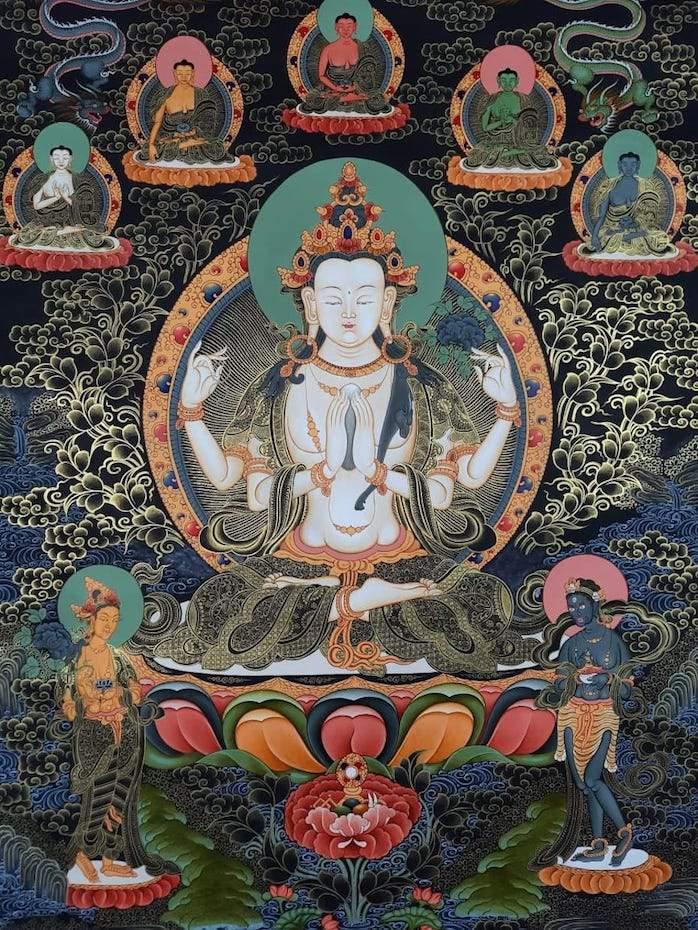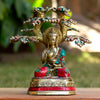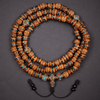Tibetan Buddhist Deities Details

Amitabha Buddha Thangka
Thangka painting depicting Amitabha Buddha is also known as 'The Buddha of Immeasurable Light and Life. Amitabha was a king who renounced his throne to become a monk. According to Mahayana scriptures, Amitabha possesses infinite merits resulting from good deeds over past lives as a bodhisattva named Dharmakara. Buddha Amitabha now reigns over 'Sukhavati', the western paradise, also known as the 'Pure Land'.Amitabha is a symbol of comprehensive love, longevity, and wisdom. He has red skin and is dressed in monk's robes sitting in a lotus position. His hands are folded in a meditation mudra holding a bowl containing the nectar of immortality.
Aparmita Buddha Thangka
Thangka painting depicting Aparmita is the manifestation of Amitabha Buddha in his Bestower of Longevity aspect. He is commonly regarded as either a celestial Buddha of Infinite Life or a fully-realized Bodhisattva. Aparmita attained Buddhahood many eons ago as a result of his merit accumulated over past lives as a Bodhisattva. Apartmita is seated on a double lotus pedestal with his hands in a meditative gesture (Dhyana Mudra) holding his identifying attribute, the vase of elixir (Kalasha). His hand gesture represents the unity of wisdom and compassion. Aparmita wears a crown and regal jewelry consisting of elaborate necklaces, large earrings inset with coral and turquoise stones, and a flowing scarf over his shoulders that loops at the elbows and falls over the lower arms.
Bodhisattva Buddha Thangka
Bodhisattva is the Sanskrit phrase for anyone who has formed Bodhicitta, a spontaneous wish, and compassionate mind to accomplish Buddhahood for the privilege of all sentient beings. The Jataka Tales, which are the stories of the Buddha's past lives, depict the various attempts of the bodhisattva to embrace qualities like self-sacrifice and divine understanding of morality.
Chakrasamvara Buddha Thangka
Thangka painting depicting Buddhist deities Heruka Chakrasamvara together with his consort, Vajrayogini. Together they represent the union of wisdom and compassion, Emptiness and Bliss, which leads directly to the Enlightenment of the mind. As a tantric Buddha, Heruka uses powers such as attachment, desire, anger, hatred as a factor to achieving Enlightenment, rather than suppressing them. He helps one redirect one's negative energies into something beneficial. Buddha Shakyamuni himself manifested in the form of Heruka Chakrasamvara to subdue the God Ishvara for the benefit of all beings. Heruka’s practice is one of the highest tantras in Buddhism and is unique because it is the only Tantra whose effectiveness increases at times of hardship.
Chenrezig Buddha Thangka
Thangka painting representing Buddhist deity Chenrezig is the embodiment of the kindness of all the Buddhas. Of a whole the Buddhist deities, the bodhisattva Chenrezig is the most celebrated. He is the lord given with complete illumination. Chenrezig has a very particular connection with Tibetans as their guardian and patron deity. His sacred mantra is Om Mani Padme Hum. It is an antique mantra that is relevant to the bodhisattva of compassion, Avalokiteshvara, and with therefore the Dalai Lama, who is supposed to be an incarnation of Avalokiteshvara. In China, Avalokitesvara is depicted in a female form known as Quan Yin.
Ganesha Thangka
Thangka painting depicting Ganesha, who is one of the best-known and most worshipped deities in the Hindu pantheon. Ganesha is widely revered as the remover of obstacles, the bestower of good luck, the patron of arts & sciences, and the deva of intellect and wisdom. The son of Shiva and Parvati, Ganesha has an elephantine countenance with a curved trunk and big ears. He is adored as the god of education, knowledge, wisdom, and wealth. Ganesha is one of the five prime Hindu deities (Brahma, Vishnu, Shiva, and Durga being the other four) whose idolatry is glorified as the panchayatana puja, one of the main Hindu prayers. Ganesha's head symbolizes the Atman or the soul, which is the ultimate supreme reality of human existence, and his human body signifies Maya or the earthly existence of human beings. The elephant head denotes wisdom and its trunk represents OM, the sound symbol of cosmic reality.
Green Tara Thangka
Thangka painting depicting Buddhist deity Green Tara is associated with enlightened activity and abundance. She is commonly thought to be a Bodhisattva or Buddha of compassion & action, a protector who comes to one's aid to relieve one's physical, emotional, and spiritual suffering. In Buddhism, her name is translated as “She Who Leads Across”, which refers to her role in helping liberate humanity from Samsara, the Ocean of Illusion. Tara in Tantric Buddhism was born from the tears of Avalokitesvara, the Bodhisattva of compassion, and she personifies his compassion. She has many forms and can be gentle or menacing depending on her color – as Green or White Tara, she is compassionate and helpful; as Red, Yellow, or Blue Tara she is fierce and protective. Green is the color of her main form and indicates her nature of active compassion. Om Tare Tuttare Ture Soha, is an ancient mantra that is related to Tara, the “Mother of all Buddhas,” and especially to her manifestation as Green Tara. Green Tara mantra is one of the three central mantras Tibetan monks and lamas read up on praying. By reciting the mantra one is said to be able to invoke the blessings of Tara and request her protection.
Life of Buddha Thangka
Thangka painting depicting the Life of Buddha narrates the most relevant life episodes of the creator of Buddhist philosophy Siddhartha Gautama Buddha. This fine art is intended to be a delineation of the headliners of the verifiable Buddha. It is also considered to be a visual representation of several philosophical aspects of Buddhism, especially the progress towards the achievement of spiritual enlightenment.
1. His Promise to Take Birth in the Human Realm and Guide Sentient Beings to Enlightenment
2. Queen Mayadevi’s Dream
3. The Birth of Buddha
4. Buddha’s Early Years and His Worldly Life
5. The Skilful Conduct of Worldly Affairs
6. The Four Encounters
7. The Renunciation of Worldly Life
8. The Six Years of Austerities
9. The Defeat of Mara
10. The Proclamation of the Teachings
11. The Descent from the Trayastrimsa Heaven
12. The Passage into Parinirvana
Related: Buy Thangka Online
Mahakala Thangka
Thangka painting depicting Mahakala is a wrathful Buddhist deity, who is considered to be the fierce and powerful emanation of Avalokitesvara and Chakrasamvara. This guardian deity defends Dharma from corruption & degeneration. He guides and protects one from all kinds of deception & delusion, and bestows the power to overcome life struggles. Mahakala is counted as one of the most important Dharmapalas, protectors of Dharma, also known as Universal Laws. Decorating his crown, are the five skulls, symbols of the transmutation of the five 'kleshas', negative emotions, into the five pearls of wisdom. His face is meant to frighten bad spirits away and keep away negative energies, thoughts, and actions. Mahakala is also worshiped by Hindus as the ultimate manifestation of Lord Shiva and his consort Mahakali, representing the enormous power of Brahman.
Manjushree Buddha Thangka
Thangka painting depicting Buddhist deity Manjushree is a bodhisattva associated with prajñā (insight). Manjushree is recognized to be the God of Divine Wisdom. According to the Buddhist tradition, he is the founder of Nepalese civilization and the creator of Kathmandu Valley. He holds the sword of light and wisdom in his right hand. His left-hand holds Prajnaparmita's original copy, the book of Divine Wisdom, on top of the lotus bloom. According to the tradition, he was a Chinese saint and is considered to be one of the Four Great Bodhisattvas of Chinese Buddhism.
Medicine Buddha Thangka
Thangka painting depicting Buddhist deity Medicine Buddha is also known as the Healing Buddha. Medicine Buddha is renowned not only for healing but also for his ability to neutralize past bad karma, bring good fortune to those in need, and help one on the path to enlightenment.'If one meditates on the Medicine Buddha, one will eventually attain enlightenment, but in the meantime, one will experience an increase in healing powers both for oneself and others and a decrease in physical and mental illness and suffering' — Lama Tashi Namgyal.
Nageshwari Maa Thangka
Thangka painting depicting Hindu deity Nageshwari Maa, who is the queen of snakes.
Padmasambhava Buddha Thangka
Thangka painting depicting Padmasambhava, who is also known as Guru Rinpoche, which in Tibetan translates as 'precious master'. He was an Indian tantric expert who assumed a significant part in carrying Vajrayana Buddhism to Tibet. He is widely venerated as a "second Buddha" by adherents of Tibetan Buddhism in Tibet, Nepal, Bhutan, and the Himalayan states of India. When Guru Rinpoche appeared as the reincarnation of Buddha Shakyamuni, the 'first Buddha', he revealed the Vajrayana teachings in their entiretyGenerally, Buddha Shakyamuni introduced "Hinayana" and Sutra Mahayana lessons, while Guru Padmasambhava showed the Vajrayana, otherwise called Tantra. Both revealed the complete and perfect path to awakening. However, Tantric teachings offer a more subtle understanding of the human experience and additional methods to realize enlightenment. In this painting, Padmasambhava has depicted seating in a royal posture holding a vajra, the weapon of Gods, in his right hand. His left-hand holds a vase filled with the nectar of longevity and wisdom.
Shakyamuni Buddha Thangka
Thangka painting depicting Shakyamuni Buddha is the founder of the Buddhist tradition. He was born in 563 BCE in Nepal. The ancient Sanskrit word 'Buddha' means 'having become awoken' in the sense of having attained 'supreme awareness'. The serene & sublime image of Gautama embodies a condition of compassionate understanding of an awoken illuminated mind.Buddha Shakyamuni was born Siddhartha Gautama, the only son of an Indian king. At his introduction to the world, it was forecasted that he would either turn into an incredible lord or the Buddha of this age. At 29 years old, he denied the advantage of his regal legacy to take up the existence of a strict drifter. He submitted himself to thorough and outrageous plain works on, advancing a superhuman battle for six exhausting years. At 35 years old, after acquiring significant knowledge into the real essence of the real world (Dharma), he accomplished total enlightenment. The Buddha Shakyamuni, right now of edification, conjured the earth as witness, as demonstrated by the fingers of his correct hand, which spread descending in Bhumisparshana Mudra. As the Buddhist Sutras relate, the sun and moon stopped, and every one of the animals of the world came to offer regard to the Supreme One who had gotten through the limits of egocentric presence.
Shiva and Shakti Thangka
Thangka painting represents Hindu divinities Shiva and Parvati (aka Shiva and Shakti). Shiva is a great yogi. He symbolizes male energy and it is the primordial energy, which represents the dynamic forces that are thought to move through the entire universe in Hinduism. Shakti on the other hand represents the female energy and is the personification of the creative and sustaining energy. The painting symbolizes that despite the gender we associate ourselves with, we encompass both male and female qualities. When we fail to acknowledge our vast energetic system we may feel chronically out of balance. One of the objectives of yoga is to overcome any barrier between the manly and ladylike and arrive at the focal channel which is considered Shushumna Nadi that gives us an unmistakable and upbeat brain for contemplation and self-acknowledgment.
Siddhi Buddha Thangka
Thangka painting depicting Siddhi Buddha is said to be able to grant various siddhis. Siddhi is a supernatural, or otherwise magical power & ability, that is the product of spiritual advancement through sādhanās, such as meditation & yoga. According to Buddhist scholars, some of these siddhis include abilities such as flying through the air, walking through solid obstructions, diving into the ground, walking on water, and so forth.
Vajrasattva Thangka
Thangka painting depicting Buddhist deity Vajrasattva, who is the Buddha of purification. He is the principle of cosmic consciousness, emptiness, and bliss. Vajrasattva is the archetype of the adamantine path of Tantric Yoga. In the painting, Vajrasattva is represented in embrace with his feminine self. It is the union of the female principle of wisdom (represented by the bell in the left hand) and the male principle of compassion (represented by the Vajra held in the right hand), which leads to harmony and wholeness.Vajrasattva is an important figure in the tantric Buddhism of the Kathmandu Valley. He represents the ideal guru, and is frequently invoked in the guru mandala. The Vajrasattva mantra is considered as having the capacity to purify karma, make peace, and cause enlightened activity.
White Tara Thangka
Thangka painting depicting Buddhist deity White Tara is the "mother of liberation" and represents the virtues of success in achievements. She offers to heal one's wounds, whether it's one's mind, body, or spirit. Tibetans usually think of Tara as having 21 manifestations, as she does in the common Tibetan Buddhist prayer — In Praise of the 21 Taras. In each structure, she takes an alternate tone — like Blue and Black — and offers alternate energy or goodness to help one on one's otherworldly way. Of these 21 Taras, the two most adored are White Tara and Green Tara. In correlation with Green Tara, who is shown situated with one leg on the ground, prepared to go to one's protection, White Tara is situated in the more reflective precious stone lotus position, with the two legs collapsed under her. She is represented with seven eyes - with an eye in her forehead, and one on each hand & foot - symbolizing her compassionate vigilance to see human afflictions. Her left hand is in the protecting mudra and her right hand is in the wish allowing mudra. In her left hand, she holds a stem of the Utpala lotus, a symbol of purity.
White Zambala Thangka
Thangka painting depicting Buddhist deity White Zambala is the God of Wealth. Among the five several Wealth Zambalas, he is recognized as one of the most compelling together with Yellow Zambala, additionally known as Kubera. White Zambala is believed to be a manifestation of Avalokitesvara and was born from his right eye. He sits on a snow lion, holding a mongoose named Nehulay, which spews forth precious jewels and ornaments. He is said to be able to grant wishes and help increase financial abundance.
You can find all available thangkas at our website at www.artoftibet.com.





